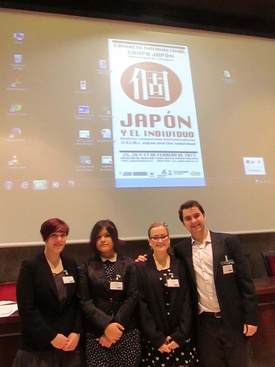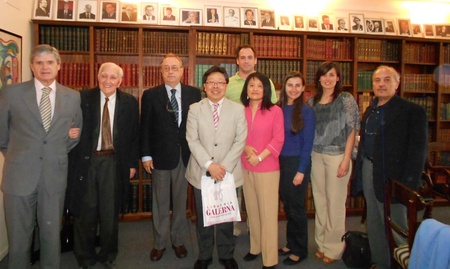In recent years, the popularity of Japanese anime, manga and Japanese cuisine has led to an increase in the number of people studying Japanese overseas, which has in turn led to an increase in the number of foreigners coming to Japan.
According to a survey conducted by the Japan Foundation in 20121, there are approximately 4 million people around the world studying Japanese language under 63,000 teachers at 16,000 institutions. Over the past 30 years, the number of learners has tripled and the number of teachers has increased six-fold, with the increase occurring mainly in Southeast Asia and China (Taiwan and South Korea have seen a decline in recent years). Many people study Japanese language out of an interest in pop culture, which is exemplified by COOL JAPAN, or in Japanese cultural elements, and conversely, not many people have the goal of working for a Japanese company in the future or studying in Japan (these countries ranked 5th and 7th, respectively, in the survey results).
While some people overseas study Japanese at university, more than 80% of learners, like Japanese people, often study at private Japanese language schools. However, in some Japanese communities, such schools have developed and been recognized as official schools by the local Ministry of Education, and Japanese language courses are recognized in addition to the curriculum in the native Spanish language. Examples of this include Liceo (Japan-Mexico Academy) in Mexico, La Union School in Peru, and Nichia Academy in Argentina.2 Private schools with bilingual elements are also notable for having a large number of non-Japanese students who are very enthusiastic about learning about Japanese culture and traditions.
Furthermore, the percentage of native Japanese teachers teaching overseas is less than a quarter (23%) of the total, and the rest are non-native speakers. The Japan Foundation report lists the following problems as a lack of teaching materials, lack of enthusiasm among students, inadequate facilities, lack of information on teaching materials and teaching methods, and a decrease in the number of students. However, since teaching materials and related materials can now be purchased or downloaded online, it is not that difficult for instructors who understand the needs of the field to create their own teaching materials.3 As for the lack of enthusiasm among students, it is said that the learning objectives of each student are so diverse that courses that satisfy each student are not being offered. However, even if the goal is to learn simple Japanese related to anime, it takes a lot of time and patience to understand the expressions and kanji.
On the other hand, for students who wish to study in Japan seriously, studying for the Japanese Language Proficiency Test (JLPT) 4 is essential. Studying for the JLPT is a step up and you have no choice but to work hard towards your goal. Of course, if it is financially possible, it is best to study at a Japanese language school.
Looking at the regional breakdown of learners, 54% are in East Asia and 28% in Southeast Asia, both of which account for 82% of the total, due to their geographical proximity to Japan and close economic and cultural ties. North America accounts for 4.5%, and South America, where there are many Japanese descendants, accounts for just under 1%. The percentage of Japanese-language learners in South America is low, but Japanese-descendant organizations, where a change of generations is underway, can expect to improve the working conditions and quality of instructors, and even develop their own teaching materials, by devising management strategies for Japanese-language schools, making them more rewarding, and strengthening their economic base.
Interest in the Japanese language leads to short-term or medium-term study abroad or tourism in Japan. The countries with the largest number of Japanese language learners are China (26.3%, 1 million people), Indonesia (21.9%, 870,000 people), South Korea (21%, 840,000 people), Australia (7.4%, 300,000 people), Taiwan (6%, 230,000 people), and the United States (4%, 150,000 people), and this is reflected in the number of international students and tourists from these countries. According to statistics on foreign tourists visiting Japan in 2015, 20 million people visited Japan5 , with the order of origin being China, South Korea, Taiwan, Hong Kong, Thailand, Singapore, Malaysia, and Indonesia. As of May 2015, 208,379 people were enrolled in universities, vocational schools, and Japanese language education institutions, of which 56,317 were studying only Japanese in order to advance to a university or vocational school.

Some Japanese language education institutions offer Japanese language classes that cater to various needs, such as Japanese culture and anime, 7 and prepare their own textbooks for each course. The characteristic of these courses is that they do not require a high level of Japanese language proficiency, and they teach specialized, practical words and expressions. On the other hand, courses aimed at entering vocational schools or universities have a curriculum that focuses on entrance exams. Some institutions also offer courses for job hunting and working adults, as well as courses in business Japanese. There are also schools that offer special courses to train foreign Japanese language teachers (non-native teachers), and the number of non-Japanese students from South America who are taking these courses to improve their skills as Japanese language teachers is gradually increasing8 .
Asian students account for 93% of all international students. By country, the largest number are from China (45% of the total, 94,111 students), followed by Vietnam (18.7%, 38,882 students) and Nepal (7.8%, 16,250 students), whose numbers have been growing steadily in recent years. Many of them hope to find employment in Japan after graduation9 . For them, the Japanese language is a tool to gain employment in Japan or at a Japanese company in their home country. They have a strong desire to get a job with a high salary and improve their family's standard of living, and they study Japanese as hard as they can with a clear goal in mind while in Japan.
Simply teaching Japanese language does not meet the diverse needs of all students. JICA receives requests to dispatch Japanese language teachers from universities and educational institutions around the world, including Japanese communities, 10 and dispatches teachers based on the skill level and type of teacher depending on the purpose and period, but finding a suitable teacher who meets the needs is said to be a source of worry. It is expected that the dispatch requirements for Japanese language teachers will incorporate different elements from the past and be more flexible in terms of purpose and period.
Looking at the government’s Cool Japan policy, 11 Japanese language education and other Japanese culture-related outreach programs match up with what Japan needs most right now: overseas PR and market development. Deepening exchanges with other countries will help expand overseas sales channels for the shrinking domestic market, while Japanese people who are knowledgeable in various fields can introduce or communicate their skills overseas, which is a form of soft power that will increase interest in Japan.
Rather than simply learning Japanese as a language, we want students to increase their interest in the Japanese language by learning about Japanese culture, history, customs, etc. How they use Japanese is ultimately up to each individual to decide, but we must strive to create many Japan fans through Japanese language study and increase the number of people coming to Japan for travel, study abroad, work, etc.

Notes:
1. The Japan Foundation's 2012 Survey of Japanese-Language Education Institutions is also available to download in English.
2. Japan-Mexico School , La Union School , Nichia School
3. The Japan Foundation's website " Spreading Japanese " and " Japanese Language Learning Materials "
4. Japanese Language Proficiency Test (JLPT)
5. Japan National Tourism Organization (JNTO) " Statistical Data "
6. Japan Student Services Organization (JASSO) " Results of the FY2015 Survey on the Enrollment Status of International Students "
Of the 200,000 international students, 67,472 are enrolled in undergraduate universities, 56,317 in Japanese language schools, 41,396 in graduate schools, and 38,654 in vocational schools.
7. Some reference cases: TIJ Tokyo Japanese Language Institute , SJI - Sendagaya Japanese Institute
8. The Japan Foundation's Japanese Language Institute offers a variety of training programs for Japanese language teachers overseas, many of which are open to public applications. " JF Japanese Language Course "
9. JASSO offers a monthly scholarship of 48,000 yen to privately funded international students. There are also scholarships provided by the school itself and grants from private foundations.
10. JICA Knowledge Site (Japanese Language Education) Dispatch Track Record " Japanese Language Education "
11. Ministry of Economy, Trade and Industry " Cool Japan Creative Industry "
Cool Japan Fund (Overseas Demand Development Fund Inc.) " Investment Schemes and Related Regulations "
© 2017 Alberto J. Matsumoto






